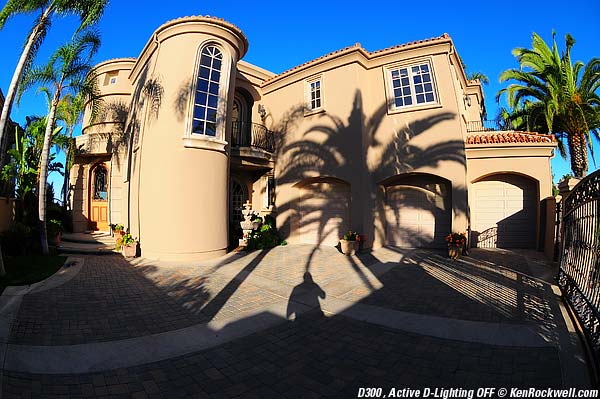Home Donate New Search Gallery How-To Books Links Workshops About Contact
Nikon Adaptive Dynamic Range (ADR)
© 2012 KenRockwell.com. All rights reserved.
April 2012, January 2008 More Nikon Reviews
Introduced with the Nikon D3 and D300 in Fall 2007, "Automatic D-Lighting" is Nikon's lingo for how we set pretty much every Nikon introduced since 2007 to adapt their dynamic ranges automatically to fit whatever highlights and shadows we throw at them.
I call this ADR, for Adaptive Dynamic Range. Nikon calls it "Active D-Lighting," which makes no sense. I'll pass on Nikon's words. When you read "ADR," you'll only find it in your D300 or D3 menu as "Adaptive D-Lighting. You could also call it the cuter "Adaptive Dynamic Range Accommodation" (ADRA), but I won't go there.
ADR visibly improves my biggest complaint against digital cameras. This feature automatically identifies highlight areas that will be lost, and does its best to bring them under control. It works, and it works automatically. You have to activate it in the menus, which I'll explain below.
Unlike the impractical Fuji S5, this function just works and doesn't slow anything down.
Roll your mouse over this image to see what it does:
Hotel California. Roll your mouse over to see Active D-Lighting in action. (each exactly as shot.)
Nikon calls this "Active D-Lighting" and uses elements of my invention disclosure published back in 2005. I was hoping someone would do this in a camera ever since 2002 when I realized how horribly awful my $5,000 D1H was at rendering highlights.
Unlike the awful post-processing gimmick called "D-Lighting," this pre-correcting system works great.
The most obvious thing is that ADR (aka Active D-Lighting) preserves the hotel's color. The standard shot over exposed the wall, so it takes on the typical nasty color shifts we see on over exposed areas, like those nasty rings around a sunset sky. See how the hotel changes from yellow in the highlights to reddish-tan in the darker areas? That's not how it looks.
Roll your mouse over, and the color just fixed itself, since the D300 prevented the red channel from blowing out. This is also obvious on the camera's RGB histograms.
This was one of my very first shots on the first morning with my D300. After I picked myself up off the ground, but before the guards threw me out, I looked at the shadows. They are subtly lighter in the ADR image, even with the walls exposed less. Unlike the crappy D-Lighting post-processing of the D40 and D80, this lightening is subtle and doesn't have horrific shadows around them as the old D-Lighting (in the retouch menu) did. I love ADR so much I leave it on all the time.
It works the same on my D3.
How to Activate ADR top
ADR is off by default. I turn it on, and never turn it off.
On the D3 and D300:
MENU > SHOOTING MENU > Active D-Lighting > Normal.
ADR Settings top
The settings are Off (default,) Low, Normal and High.
I use normal. Play around if you like; the variation is mostly in the amount of lift applied to the shadows.
Shooting Rates and Buffer Depth top
Frame Rates
ADR doesn't slow the shooting rate, as it does in the Fuji cameras. You'll never know it's on, except for the better images and that you can see how it was set when you read the data in playback.
Buffer Depth
Because the D3 and D300 are crunching on so much extra data to encompass a greater potential dynamic range when ADR is ON, the D3 and D300 take longer to clear the buffer for each shot. There is a lot of extra processing going on that we don't see. ADR is using all 16 (linear) bits, even to create 8-bit (log) JPGs.
The buffer is 13 shots with ADR ON in the D3, and 12 shots in the D300. The buffer grows to a crazy number around 40 with ADR off.
The buffer with ADR ON is always 12 or 13. The buffer depth varies with your choice of file types and sizes with ADR off.
The available buffer depth is shown in real time anytime you have the shutter partially pressed.
12-deep is more than I could ever use on a 3FPS camera, which is where my D3 and D300 are usually set. If I'm trying to shoot long sequences at 9FPS, the buffer fills in 1.5 seconds with ADR On.
If you fill the buffer, which simply slows the frame rate, feel free to deactivate ADR for that shoot. I never do.
Back to Nikon D300 Review or Back to Nikon D3 Review
Back to Page Index of Nikon D300 Review or Page Index of Nikon D3 Review
PLUG top
I support my growing family through this website, as crazy as it might seem.
If you find this as helpful as a book you might have had to buy or a workshop you may have had to take, feel free to help me continue helping everyone.
If you've gotten your gear through one of my links or helped otherwise, you're family. It's great people like you who allow me to keep adding to this site full-time. Thanks!
If you haven't helped yet, please do, and consider helping me with a gift of $5.00.
The biggest help is to use these links to Adorama, Amazon, B&H, Calumet, Ritz and J&R when you get your goodies. It costs you nothing and is a huge help. These places have the best prices and service, which is why I've used them since before this website existed. I recommend them all personally.
Thanks for reading!
Ken
Home Donate New Search Gallery How-To Books Links Workshops About Contact

